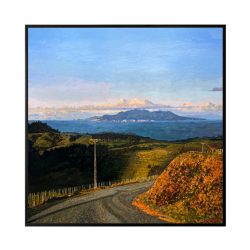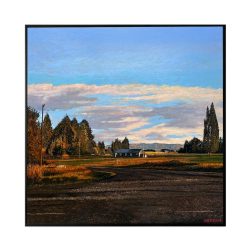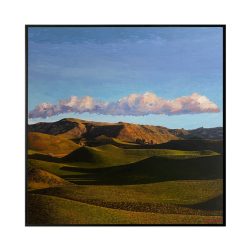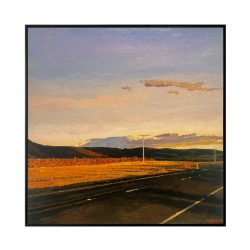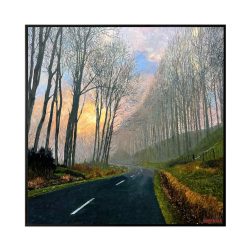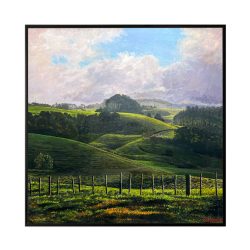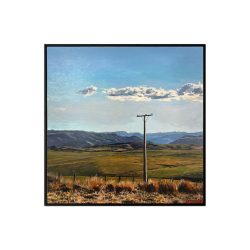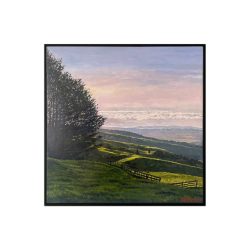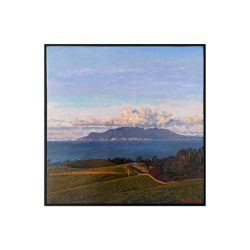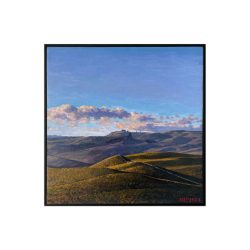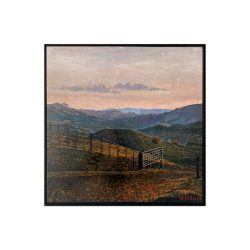Matt Palmer | 12 Paintings
1 – 28 Feb
Matthew Palmer: 12 Paintings
– Toni MacKinnon, 2024
Landscape painting is not without its risk. For a start, the artist is up against history, four to five hundred years of it. Beginning in earnest when artist Joachim Patinir (c. 1480 d. 1524) first made landscape more than just the background of a work, treating it as a serious topic.
And although few of us can claim to be unaffected by images of the natural world and the associations we project onto them, landscape painting seems largely cut adrift from critical contemporary art.
Painters such as Peter Doig, Stephan Peters and of late, David Hockney, inhabit a rarefied space in validifying and giving proper voice to this tranquil, pictorial art form. Palmer is an artist we can add to this group, with his ever-expanding series of paintings where he explores the emotive potential of landscape.
Living in Australia, Palmer returns periodically to Aotearoa for his imagery. His most important visual material are photographs that he takes on immersive road trips in the North Island. He drives the back roads, getting out of the car to walk up hills for the view, stopping to swim in waterholes along the way – it is a home coming, a kind of baptism in place.
Formally, the paintings are of varying sizes, they are painted in acrylic on board, in saturated colour, sometimes square and sometimes rectangular. Twelve Paintings is Palmer’s most overtly autobiographical work. The paintings are sparer and more spontaneously gestured so they emote more directly.
While they have their roots in the picturesque, with gentle hills, curving roads, mountains in the background and golden evening skies, like landscapes of the Romantic period they mine the analogy between nature and the psyche.
Titled for their views; Whangateau looking southeast; Waiouru looking north; Cape Rodney looking east, Palmer puts himself more squarely in the work – he is looking east, north, and south. Reconfiguring the picture digitally before painting Palmer is mining the morphic potential of his process to create a viewpoint somewhere between what he sees, and what he is looking for.
Palmer’s paintings have a cinematic quality. A lone telephone pole, fences extending into the distance, or a road disappearing, demonstrate his profound grasp of the symbolic aspect of mise en scene. Palmer uses these elements as a visual language to convey ideas of boundaries, connections, and transitions.
In the paintings distinctions are made: nearness – distance; home – away. The paintings navigate displacement and relocation. In works like Whangateau looking southeast, light sets up Palmer’s connection to place. Warmth lights hills in the foreground and cool hues make distant islands more remote.
Twelve Paintings comes out of his return home and having lived in Sydney for over twenty years, it is no surprise that these landscapes are infused with nostalgia. Pricilla Pitts writes that “Landscape painting in Aotearoa has been understood as having a role in shaping and reshaping our understanding of nationhood and national identity.”[i] Palmer is leveraging that history as strategy for negotiating a sense of place.
Navigating the interplay between external landscapes and the psyche, Palmer’s paintings function as a psychological anchor, through which he reinstates his relationship with home, from a distance.
- [i] Priscilla Pitts, ‘The Unquiet Earth: Reading landscape and the land in New Zealand art’ in Headlands: Thinking Through New Zealand Art, Museum of Contemporary Art, Sydney, 1992, p. 87.
Contact the gallery for the full exhibition catalogue
